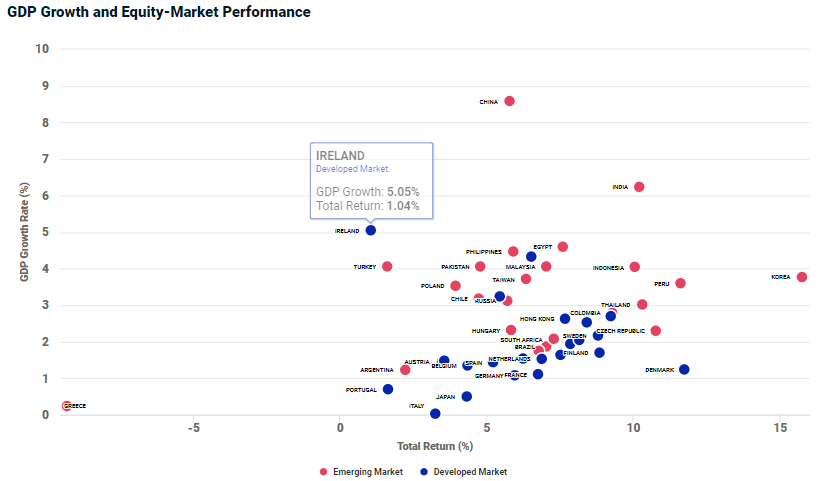Does positive GDP growth lead to strong stock returns?
Traditionally, GDP growth has been thought of as a leading indicator for domestic stock-market performance. But has this changed?
The chart below compares average rates of GDP growth to stock-market performance, from 1998 to 2020. The high level of dispersion between economic growth and stock performance means there was low correlation between the two. In other words, during this period, GDP growth was not a strong indicator of stock-market returns.
Why this disconnect? First, increased globalization means that domestic stock markets may be more exposed to global growth drivers than domestic ones. It's also possible that stock markets had already priced in expectations about future economic growth. Finally, supportive monetary policies around the global have driven capital flows into riskier assets like equities, potentially severing the link between the real economy (proxied by GDP growth) and stock market performance and valuations.
Investors may want to account for this as they evaluate investments in higher-growth economies given that the higher growth may not necessarily translate into a strong stock market performance.
Financial Performance versus GDP Growth

IMF data from 1998 to 2020. Total return measures standard index total return for each country.
Subscribe todayto have insights delivered to your inbox.
Global Investing Trends to Watch
You’ll find insights provided in research papers, blogs and a Chart of the Week that succinctly puts topical issues in context.
Where next in terms of Global Growth?
While most countries’ real GDP growth was buffeted in 2020 by the COVID-19 pandemic, the emerging market & developing economies were less affected (-3.3%) than advanced ones (-5.8%).
Global Research and Development Spending as Percentage of GDP
Corporate and government spending on research and development (R&D) accounted for about 2% of GDP globally, as of December 2018, with wide variation by country.
1 Source: IMF data from 1998 to 2020. Total return measures standard index total return for each country.
The content of this page is for informational purposes only and is intended for institutional professionals with the analytical resources and tools necessary to interpret any performance information. Nothing herein is intended to recommend any product, tool or service. For all references to laws, rules or regulations, please note that the information is provided “as is” and does not constitute legal advice or any binding interpretation. Any approach to comply with regulatory or policy initiatives should be discussed with your own legal counsel and/or the relevant competent authority, as needed.
